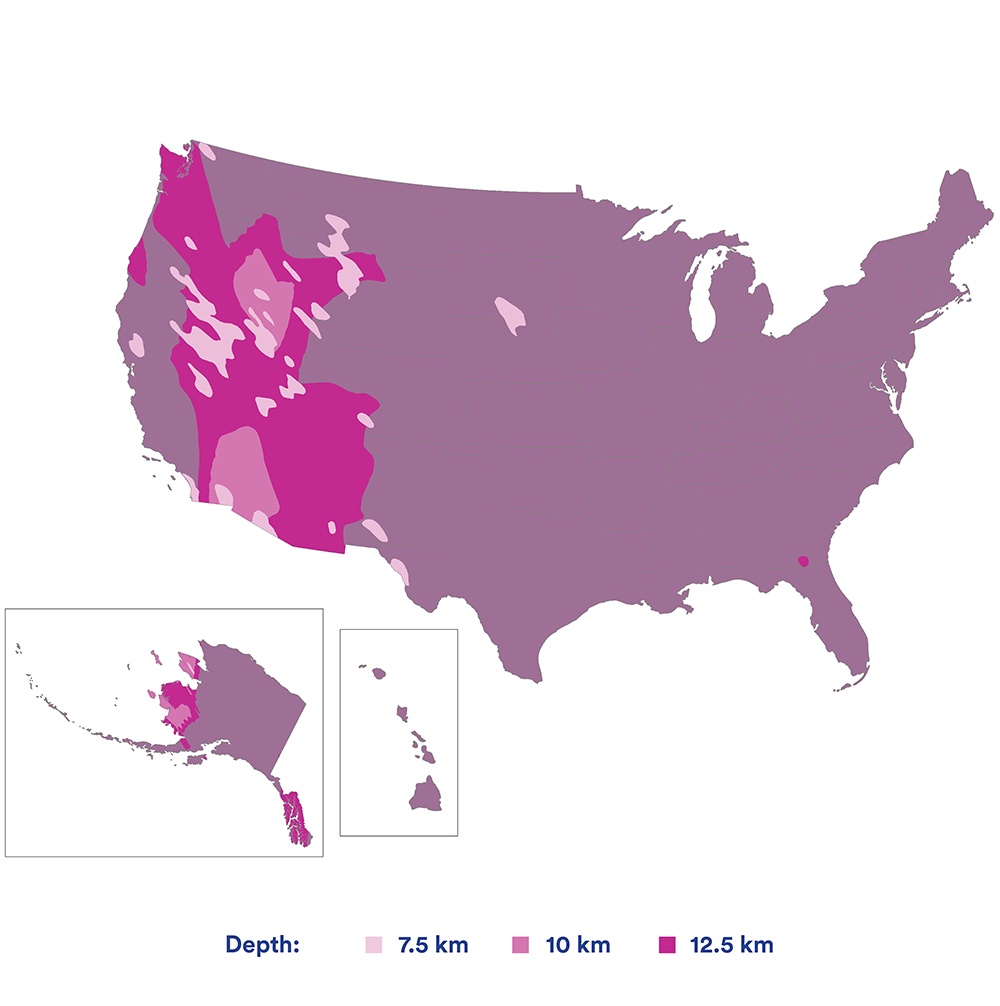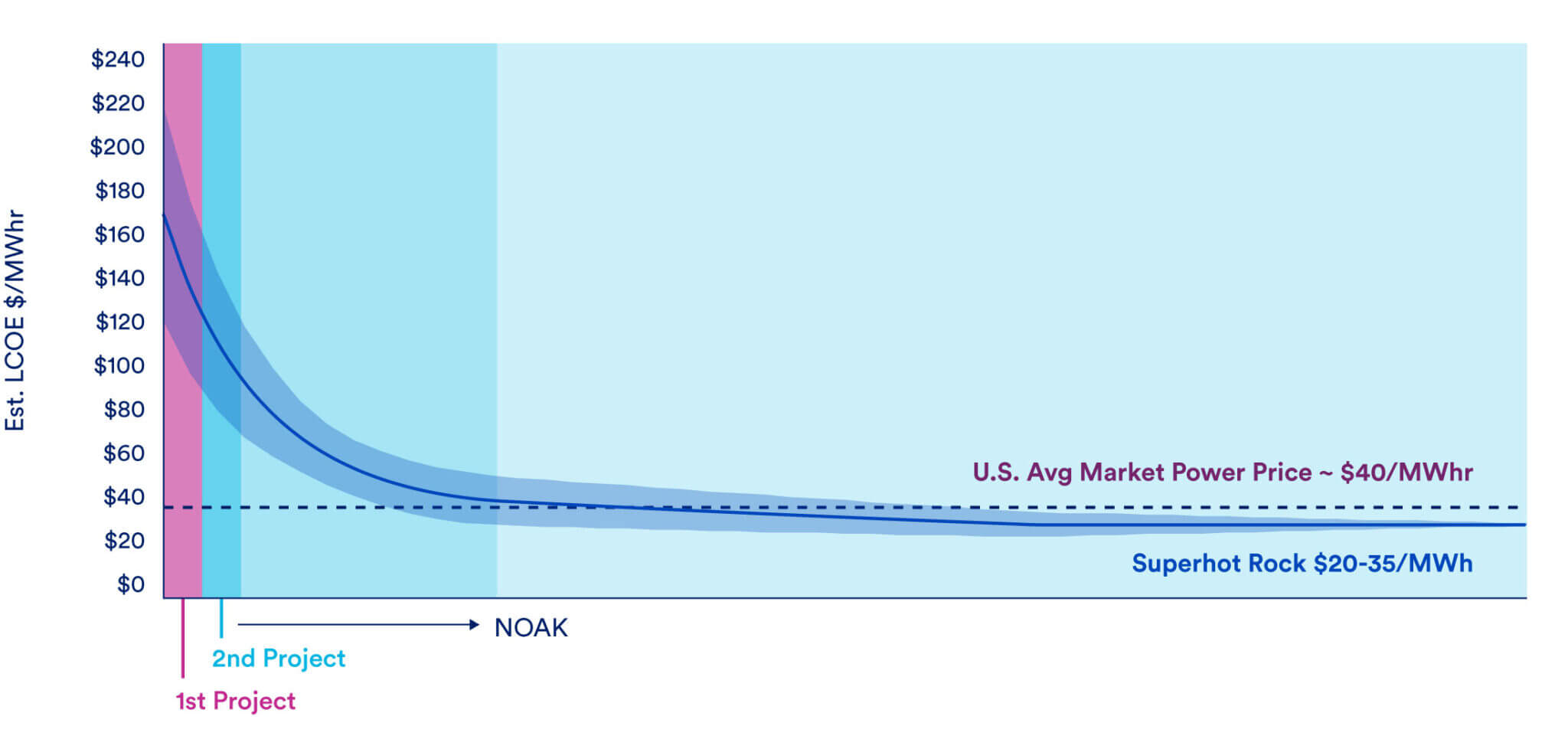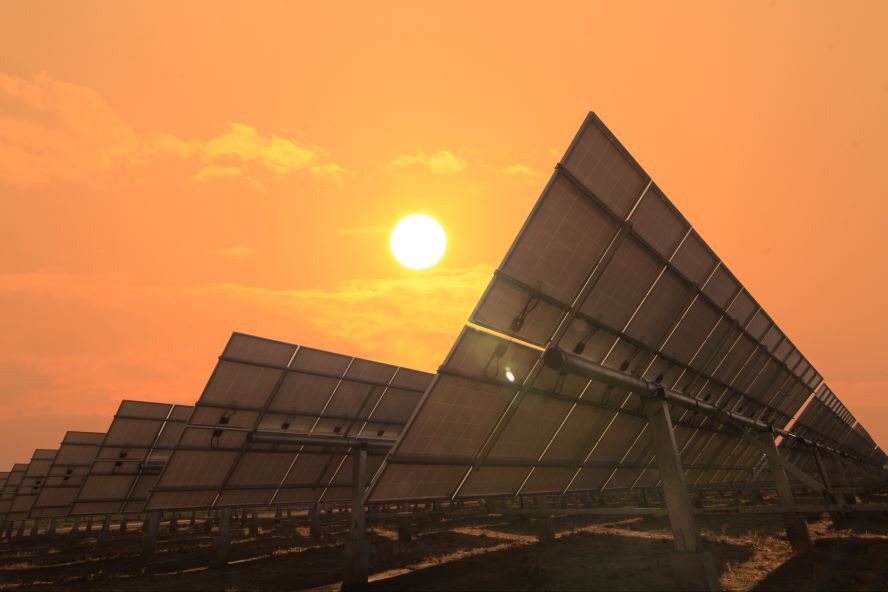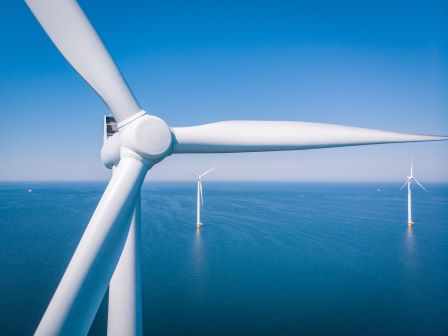A new modeling tool unveiled this week by the Clean Air Task Force (CATF) shows 63 terawatts of clean power could be generated by harnessing just 1% of superhot rock belowground.
That would be enough geothermal energy to meet 2021’s global energy demand by nearly eight times over, according to Terra Rogers, director for superhot rock at the CATF.
“Dozens of wells across the globe have reached superhot conditions, and with the right technical and commercial advances, we could see early commercial-scale plants in years, not decades,” Rogers said in a statement.
A temperature of at least 400 C is considered superhot. That’s more than twice the 400 F or so needed to bake a frozen pizza in an oven.
The model, created in collaboration with the University of Twente in The Netherlands, calculates the steady-state, conductive heat transfer in the lithosphere. It was released as the geothermal sector continues to attract attention amid global efforts to lower greenhouse gas emissions and meet power demand.
Geothermal drillers have made strides in recent years with improved drilling techniques, including those used by the oil and gas sector, to produce more energy quicker.
However, most drillers are not tapping into superhot rock, which is typically found, in the U.S. for example, at depths below 8 miles (12.5 km).

CATF’s model shows that about 20% of U.S. land has superhot rock energy potential that could be unlocked with deep drilling research and technology innovation. Tapping only 1% of superhot rock resources in the U.S. could lead to 4.3 terawatts of energy capacity, generating nearly 36,000 terawatt-hours (TWh) of electricity, according to the CATF.
“To provide perspective, New York City consumed 53 TWh of electricity in 2019, so the United States’ superhot rock energy resource capacity could theoretically satisfy the annual electricity demands of nearly 680 additional cities equivalent to New York City,” it said.
Though initial costs of producing electricity from superhot rock will be higher for the first projects, CATF says costs could follow cost decline paths similar to unconventional shale gas, solar and wind, while also taking up less land.

Here is a look at other renewable energy news.
RELATED
Investors: Energy Transition is on Policy-driven Life Support
Mitsubishi, Chevron Overcome Hydrogen, Storage Project Woes
CERAWeek: NextEra CEO: Growing Power Demand Opportunity for Renewables
Government, Private Sector Learning to ‘Dance’ Towards Transition
Viridi Energy Acquires Maine Biosolids Plant for RNG
Energy storage
American Battery Factory Forms Partnership for Arizona Gigafactory
American Battery Factory (ABF) teamed up with Lead Intelligent Equipment (LEAD) for custom automation equipment and machinery to use at the gigafactory ABF is developing in Tucson, Arizona, the company said March 18.
The lithium iron phosphate battery cell manufacturer said the partnership marks a key milestone in its efforts to finalize engineering details and start construction of its first gigafactory. With capacity of up to 20 gigawatt hours (GWh), the plant will have a fully automated production line.
“From mixing and coating to stacking and packaging, machinery including the slurry system, cathode and anode laser chamber and turnkey line equipment will cover every key step of the battery cell manufacturing process,” ABF said in the release. “In addition to the machinery, LEAD will initially provide onsite support, including system installation, commissioning and training.”
India’s First Battery Storage Gigafactory to Start Operating by October
(Reuters) GoodEnough Energy said March 19 it will start operations at India’s first battery energy storage gigafactory in the northern region of Jammu and Kashmir by October.
The facility will help the industry cut more than 5 million tons of carbon emissions in a year, GoodEnough said in a statement. India has set a 2070 goal for becoming net zero.
GoodEnough has already spent 1.5 billion rupees (US$18.07 million) on the 7 GWh facility and will spend 3 billion rupees (US$ 35.9 million) by 2027 to raise capacity to 20 GWh, its founder Akash Kaushik said.
Battery energy storage projects are critical to India’s ambitious plan to expand its renewable energy capacity to 500 gigawatts (GW) by 2030, from 178 GW at present.
India’s government is offering $452 million in incentives to companies under a program to promote battery storage projects.
Such systems enable the storage of energy from solar, wind and other renewable sources so it can be released when needed.
RELATED
Discovery Lithium Signs LOI to Acquire Midex Resources
Occidental’s Lithium Technology ‘Ready for Prime Time’
Hydrogen

ABB, Green Hydrogen to Collaborate on Power-to-X Project in US
ABB agreed to collaborate with Green Hydrogen International (GHI) on a U.S. project aiming to produce 280,000 tons of green hydrogen per year to make green ammonia.
As part of the agreement, ABB on March 19 said its automation, electrification and digital technology will be assessed for deployment at GHI’s Hydrogen City project. Construction is expected to begin in 2026 with first production starting in 2030.
The project, which will be developed in phases, will utilize solar and wind energy to power a 2.2-GW electrolyzer to produce hydrogen. About 100 million tons of green ammonia will be produced annually from the green hydrogen for global export. Plans also include using an underground salt cavern to store hydrogen to help with renewable energy intermittency, the release states.
The technology company said it plans to supply its Integrated Control Safety System with the distributed control system ABB Ability System 800xA to improve efficiency, operator performance and asset utilization. The agreement also includes electrical motors and drives, measurement and analytics solutions and power and process optimization solutions, according to the news release.
Canada Signs Hydrogen Deal with Germany, Cites Need to Shun Russia Energy
(Reuters) Canada, citing the need to shun Russian energy, signed an agreement with Germany on March 18 that it said would accelerate work toward the commercial-scale trade of clean hydrogen fuel.
The two nations inked a memorandum of understanding committing them to backing transactions between Canadian hydrogen producers and Germany’s industrial manufacturing and energy distribution sectors.
“Canada is working with European allies to displace imports of Russian oil and gas and fight climate change with clean Canadian hydrogen. Canada can be a world-leading producer and exporter of clean hydrogen,” the federal natural resources ministry said in a statement.
In August 2022, Canadian Prime Minister Justin Trudeau and German Chancellor Olaf Scholz agreed to establish a transatlantic supply corridor while coordinating policies to attract investments in hydrogen projects. The deal envisaged Canadian exports to Germany starting in 2025.
Hydrogen is a zero-carbon fuel best suited for powering large industrial machines, heavy vehicles and for heating.
More than 80 low-carbon hydrogen production projects have been announced in Canada to date. Last year, one of the first projects delayed its start by one year because the operator’s European customers needed more time to develop special infrastructure to handle the product.
Solar

EDP Renewables, Volt Partner to Develop Solar Project
EDP Renewables North America said March 19 it partnered with Volt Energy Utility to develop a photovoltaic (PV) project in Illinois, having already sealed a power purchase agreement (PPA) with Microsoft.
Hickory Solar Park, located near Jerseyville, Illinois, will have a capacity of 110 megawatts (MW).
“The agreement for Hickory uses an Environmental Justice PPA form developed by Microsoft and Volt Energy, a minority-owned renewable energy developer, focused on making clean energy investments in rural and urban communities disproportionately impacted by environmental injustices—all of whom are behind in securing the benefits of a clean energy economy,” the news release states.
The tech giant agreed to purchase electricity and renewable energy credits for 15 years from the project. As part of the PPA, Hickory will help fund the Sharing the Power Foundation, which supports groups and initiatives advancing environmental justice.
Sunlight Energy Acquires Solar Project in Indiana
Genie Energy subsidiary Sunlight Energy Investments grew its solar portfolio with the acquisition of a late-stage solar development project in Hamilton, Indiana, the New Jersey-based company said in a March 21 news release.
Electricity produced from the project will power Hamilton Community high and elementary schools as part of a fixed-price power purchase agreement, the company said.
“The Hamilton project acquisition fits perfectly with our growing portfolio of solar projects providing long-term, stable cash flows,” said Sunlight Energy CEO Nir Ashpiz. “Backed by Genie Energy’s robust balance sheet, we continue to scout for additional solar generation assets and projects with opportunities for participation from third-party investors.”
Sunlight previously purchased 12 operational solar arrays serving educational facilities in Ohio and Michigan, it said.
Additional details about the most recent transaction were not disclosed.
Recurrent Energy Grows Solar Assets in Spain with Acquisition
Canadian Solar subsidiary Recurrent Energy acquired a solar PV portfolio with a more than 420-MW capacity, according to a March 20 news release.
Located in Carmona, south of Spain, the portfolio includes the Rey I, II, III and IV projects. Currently under construction, the projects will feature Canadian Solar’s TopBiHiKu7 N-type bifacial TOPCon (Tunnel Oxide Passivated Contact) technology modules, the company said.
Combined, the projects are expected to produce about 916,000 MWh of energy annually, enough to serve over 275,000 homes.
Doral Renewables Closes Financing for Ohio Solar Project
Philadelphia-based Doral Renewables on March 21 said it secured $114 million in financing from HSBC for the Great Bend Solar project in Meigs, Ohio.
Located on 370 acres, the project will be a ground-mounted single-axis PV system with 48 MW of solar power capacity, the company said in a news release. Once complete, the project is expected to provide enough electricity to power about 9,000 homes.
The debt financing included a $36 million construction-to-term loan facility, a $57 million tax equity bridge loan and a $21 million letter of credit facility, according to the release.
KKR to Buy Majority Stake in Solar Developer Avantus
(Reuters) KKR said on March 20 it would buy a majority stake in Avantus, a U.S. developer of large utility-scale solar and solar-plus-storage projects.
The private equity firm, alongside Avantus’ existing investor EIG, expects to invest at least $1 billion in the company.
The solar developer could see growth in demand on expectations for lower interest rates this year, coupled with incentives and benefits for clean energy firms under the Inflation Reduction Act.
Avantus, previously known as 8minute Solar Energy, owns a project pipeline of 30 GW of solar and 94 GWh of battery storage. It has sold 6.5 GWp and 6.3 GWh of solar and storage projects, respectively.
EDP Renewables Starts Up Cerca PV Plant in Europe
EDP Renewables started operations at the 202-MW Cerca PV plant in Portugal, the company’s largest solar plant in Europe.
Located in the municipalities of Alenquer and Azambuja, north of Lisbon, the plant features more than 310,000 bifacial solar panels. The plant will have an estimated annual production of 330 GWh, which EDP said is enough to supply about 100,000 families—about 1% of the national population—with power.
The plant’s startup lifts EDP’s solar capacity in Portugal to 540 MW.
“At EDP, we are looking at dozens of new solar projects that will make a significant contribution to this path,” said Duarte Bello, EDP Renewables’ COO for Europe and Latin America.
EDP said it sees solar as one of its main avenues for growth and that half of its global investments will be in large-scale solar projects and decentralized generation by 2026. It currently has about 4.3 GW of installed solar capacity globally.
Nigeria’s Sovereign Fund to Pilot Development of 20MW Solar Plant
(Reuters) Nigeria’s sovereign fund plans to build a 20-MW solar power plant in partnership with a local firm, the country’s Vice President Kashim Shettima said March 19.
Shettima said the 20-MW pilot project is embedded within a 300-MW solar program, to be co-located within NSP’s existing 600-MW Shiroro Hydroelectric Power Plant concession area in Shiroro, Niger State.
Shettima did not disclose the cost of the project or when construction will start.
Nigeria, with a population of more than 200 million people, has installed power generation capacity of 12,500 MW but produces a fraction of that, leaving millions of households and businesses reliant on petrol and diesel generators.
The Shiroro Generating Co. is a hybrid project is located in Shiroro, in Nigeria’s northwest of Niger state.
Wind
Shell Sells SouthCoast Wind Stake to Ocean Winds

Shell on March 20 said it sold its 50% stake in the 2.4-GW SouthCoast Wind project off Massachusetts to joint venture (JV) partner Ocean Winds North America.
The deal, which was structured to simultaneously sign and close effective immediately, was carried out as Shell realigns its portfolio to focus on renewable projects in key markets where it has an advantaged position.
Inflation, interest rates and supply chain disruptions have challenged U.S. offshore wind in the past year, contributing to impairments and canceled projects.
“We are grateful to Ocean Winds for their years of partnership within this venture, and continue to seek opportunities to provide more energy, with fewer emissions,” said Glenn Wright, senior vice president of Shell Energy Americas.
Ocean Winds is a 50-50 JV owned by EDP Renewables and ENGIE. SouthCoast Wind was formerly called Mayflower Wind Energy.
Japan Chooses JRE, Ibedrola, Tohoku Electric for Offshore Wind Farm
(Reuters) The Japanese government chose a consortium comprising Japan Renewable Energy, Iberdrola Renewables and Tohoku Electric Power as the wind power operator for an offshore block tendered in a second round of auctions, it said March 22.
The 375-MW wind farm is located off the coast of Happo-Noshiro in Akita prefecture in northern Japan and is part of Japan's efforts to grow its offshore wind market to 10 GW by 2030, and up to 45 GW by 2040.
Danish wind turbine maker Vestas will provide turbines for the Happo-Noshiro project that should be launched in June 2029, the government's statement said.
The second major public auctions round aims to build a total of 1.8 GW of capacity across four blocks.
“Japan has ambitious targets for offshore wind development, and it is a market Iberdrola has been contributing to for several years now,” said Xabier Viteri, global director of Iberdrola’s renewables business.
“This latest development expands our options to deliver new projects in the years ahead.”
Each of the three winning consortia comprised a trading house and either an electricity or a gas utility.
The selection process for the Happo-Noshiro block was delayed due to the overlapping use of a port.
RELATED
US Proposes Second GoM Wind Lease Auction
Reuters and Hart Energy Staff contributed to this report.
Recommended Reading
Delek Logistics Offering Senior Notes to Pay Off Debt
2024-08-15 - Delek Logistics Partners and its subsidiary plan to use the net proceeds from the senior notes offering to pay off a portion of the outstanding borrowings from its credit facility.
Dividends Declared in the Week of July 22
2024-07-25 - Second quarter earnings are underway, and companies are declaring dividends.
Dividends Declared in the Week of Aug. 2
2024-08-02 - Here is a selection of dividends declared for the week of Aug. 2 for a selection of upstream, midstream and service & supply companies.
Upstream, Midstream Dividends Declared in the Week of July 8, 2024
2024-07-11 - Here is a selection of upstream and midstream dividends declared in the week of July 8.
Trans Mountain Appoints New CEO, President
2024-08-23 - Trans Mountain appointed Mark Maki to CEO, succeeding Dawn Farrell who will now be chairman of the board.
Comments
Add new comment
This conversation is moderated according to Hart Energy community rules. Please read the rules before joining the discussion. If you’re experiencing any technical problems, please contact our customer care team.






